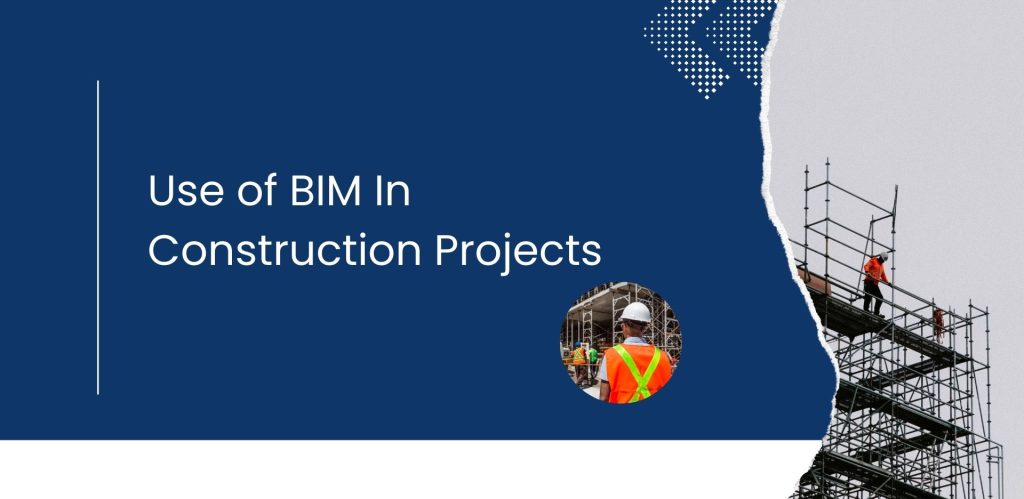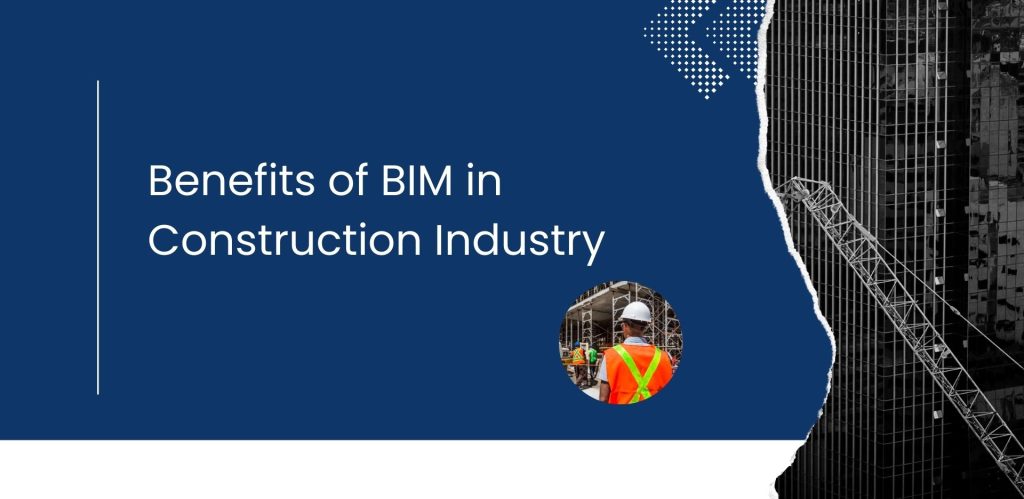Building Information Modeling (BIM) encompasses the virtual modeling of the entire project, including architectural, structural, mechanical, and electrical elements.
BIM provides a collaborative platform for various stakeholders, allowing them to work together seamlessly from initial planning to facility management.
This article explores the benefits of BIM in construction projects and the ultimate benefits of BIM in the construction industry, highlighting its impact on efficiency, collaboration, cost savings, and sustainability.
Use of Building Information Modeling (BIM) in construction projects

The use of Building Information Modeling (BIM) in construction projects offers numerous advantages and benefits.
Here are some key applications and uses of BIM in the Construction Industry:
Visualization and Design
BIM allows architects, engineers, and stakeholders to create and visualize detailed 3D models of buildings and structures. This helps in better understanding the project and making informed design decisions.
Collaboration and Communication
BIM serves as a collaborative platform, enabling real-time sharing of project information among team members. It enhances communication, coordination, and collaboration between various disciplines involved in the project.
Clash Detection and Conflict Resolution
BIM software includes clash detection features that identify potential clashes and conflicts between different building components, systems, and disciplines. This helps in resolving conflicts before construction, minimizing rework and delays.
Quantity Takeoffs and Cost Estimation
BIM facilitates accurate quantity takeoffs, material scheduling, and cost estimation. It enables the generation of detailed bills of quantities, helping contractors in cost planning and procurement.
Construction Sequencing and Scheduling
BIM allows for the creation of construction schedules and sequencing based on the 3D model. This helps in optimizing resource allocation, identifying critical paths, and improving project timelines.
Prefabrication and Modular Construction
BIM can be used to design and plan prefabricated and modular components. It aids in the coordination and assembly of prefabricated elements, leading to faster construction and improved quality control.
Facility Management and Maintenance
BIM models serve as valuable assets for facility managers. They provide access to essential information about the building’s components, maintenance schedules, and performance data. BIM supports proactive maintenance, efficient operations, and better facility management.
Energy Analysis and Sustainability
BIM software enables architects and engineers to simulate and analyze the energy performance of buildings. It helps in optimizing design choices for energy efficiency, integrating renewable energy systems, and promoting sustainable practices.
Virtual Reality (VR) and Augmented Reality (AR)
BIM can be integrated with VR and AR technologies to create immersive experiences and virtual walkthroughs of the construction project. This enhances visualization, stakeholder engagement, and design review processes.
Data Management and Documentation
BIM centralizes project data and documentation, making it easily accessible and updatable throughout the project lifecycle. It improves data organization, version control, and information retrieval.
These are examples of how BIM is used in construction projects. The adoption of BIM has transformed the industry by enhancing collaboration, improving efficiency, reducing errors, and optimizing project outcomes.
Ultimate benefits of BIM in the construction industry

Enhanced Collaboration and Communication
One of the primary benefits of BIM in the construction industry is improved collaboration and communication among project teams.
BIM enables real-time sharing of project information, facilitating coordination between architects, engineers, contractors, and other stakeholders.
Through a centralized platform, everyone involved can access and contribute to the project, reducing miscommunication and conflicts.
Streamlined Project Planning and Design
BIM software offers powerful tools for project planning and design.
It allows architects and engineers to create detailed 3D models of buildings, enabling better visualization and understanding of the project.
With BIM, design conflicts and clashes can be identified and resolved in the virtual environment, saving time and resources during the construction phase. Additionally, BIM facilitates accurate quantity takeoffs, material scheduling, and cost estimation.
Improved Construction Efficiency
BIM significantly enhances construction efficiency by optimizing various processes.
Through clash detection and coordination functionalities, BIM identifies potential conflicts in the design stage, reducing the need for rework and change orders during construction.
Furthermore, BIM enables the generation of accurate construction schedules and sequencing, leading to better resource allocation and improved project timelines.
Cost Savings and Risk Reduction
Implementing BIM in the construction industry can result in substantial cost savings and risk reduction.
By identifying clashes and design issues early on, construction errors and rework can be minimized, saving both time and money.
BIM also facilitates accurate cost estimation and quantity takeoffs, enabling contractors to make informed decisions and avoid costly surprises during the construction phase.
Additionally, BIM allows for better risk analysis and mitigation strategies, enhancing project outcomes.
Sustainable and Environmentally-Friendly Practices
BIM enables architects and engineers to simulate and analyze the energy performance of buildings, optimizing design choices for energy efficiency.
BIM also facilitates the integration of renewable energy systems and the use of sustainable materials, contributing to greener construction practices.
By considering environmental factors during the design phase, BIM helps reduce the carbon footprint of construction projects.
Enhanced Facility Management
Beyond the construction phase, BIM continues to deliver benefits in facility management.
The digital models created during the design and construction stages serve as valuable assets for facility managers.
BIM provides access to crucial information about the building’s components, maintenance schedules, and performance data.
This data-driven approach allows for proactive maintenance, efficient operations, and improved occupant comfort.
Increased Client Satisfaction
BIM’s collaborative and transparent nature fosters better communication with clients throughout the project lifecycle.
Clients can visualize and interact with the virtual model, gaining a clear understanding of the final product.
BIM enables clients to provide feedback and make informed decisions, leading to higher satisfaction levels.
Additionally, the ability to visualize the project before construction helps align client expectations with the actual outcome.
Conclusion
Building Information Modeling (BIM) offers a wide range of benefits to the construction industry.
From enhanced collaboration and communication to streamlined project planning and design, improved construction efficiency, and cost savings, BIM has revolutionized the way construction projects are executed.
Furthermore, BIM promotes sustainability, facilitates efficient facility management, and ultimately leads to increased client satisfaction.
FAQs
Is BIM only applicable to large-scale construction projects?
No, BIM can be utilized in projects of all scales, from small residential buildings to large infrastructure projects. The benefits of BIM apply to projects of any size.
Can BIM be integrated with other software systems used in the construction industry?
Yes, BIM software can be integrated with other software systems such as project management tools, scheduling software, and cost estimation software. This integration enhances data exchange and streamlines project workflows.
Does implementing BIM require a significant investment in hardware and software?
While implementing BIM may require initial investments in hardware and software, the long-term benefits outweigh the costs. BIM improves efficiency, reduces errors, and enhances collaboration, resulting in cost savings throughout the project lifecycle.
Can BIM help in identifying and addressing construction conflicts and clashes?
Yes, BIM’s clash detection functionality helps identify conflicts and clashes in the design stage. By addressing these issues early on, construction errors and rework can be minimized.
How does BIM contribute to sustainability in the construction industry?
BIM enables architects and engineers to analyze the energy performance of buildings and make design choices that optimize energy efficiency. It also supports the integration of renewable energy systems and sustainable materials, promoting environmentally-friendly construction practices.
Read our other blogs :
Traditional vs BIM : Why Coordination Makes All the Difference
Revolutionizing Construction: Understanding the Power of BIM Coordination
How to ensure seamless construction management with BIM and its effect on the AEC industry

Leave a Reply